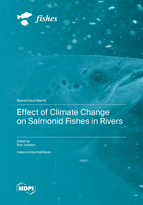Effect of Climate Change on Salmonid Fishes in Rivers
A special issue of Fishes (ISSN 2410-3888). This special issue belongs to the section "Biology and Ecology".
Deadline for manuscript submissions: closed (15 September 2023) | Viewed by 23647
Special Issue Editor
Special Issue Information
Dear Colleagues,
Climate change is a serious threat, especially to cold-adapted organisms. Among these, salmonid fishes are highly vulnerable to global warming, not only at their southern edge of distribution, but throughout the temperate climate zone. With climate warming, populations go extinct, population sizes decline and sub-lethal effects with phenotypic, epigenetic and genetic changes are observed. These include changes in the distribution, physiology, behaviour, life history and ecology of these wild populations and species. For instance, metabolic rate, growth and body size change; tendencies and timings of migrations are altered; and exotic species spread, with consequences on interspecific competition and changed threats from parasites, diseases and predators. Habitat changes occur due to an altered thermal climate, as well as changes in water depth, flow, feeding opportunities, substrate stability, oxygen concentration, particle transport and the turbidity of the water. It is important to document how these changes influence salmonid populations to reveal causes and effects, and make predictions to foresee how salmonid communities will change in the future to improve our ability to perform the proper management of populations and habitats.
This Special Issue aims to publish high-quality, novel research on the ecological effects of climate change on salmonid fishes. Manuscripts on direct climatic effects and those carried over from earlier environmental influence will be considered. Population studies as well as those on interspecific relationships are appropriate. We welcome submissions of original field as well as laboratory research. The manuscripts may be full research articles, short communications, or review articles giving directions for future research or suggestions on how to better manage populations in a changed, future climate.
Prof. Dr. Bror Jonsson
Guest Editor
Manuscript Submission Information
Manuscripts should be submitted online at www.mdpi.com by registering and logging in to this website. Once you are registered, click here to go to the submission form. Manuscripts can be submitted until the deadline. All submissions that pass pre-check are peer-reviewed. Accepted papers will be published continuously in the journal (as soon as accepted) and will be listed together on the special issue website. Research articles, review articles as well as short communications are invited. For planned papers, a title and short abstract (about 100 words) can be sent to the Editorial Office for announcement on this website.
Submitted manuscripts should not have been published previously, nor be under consideration for publication elsewhere (except conference proceedings papers). All manuscripts are thoroughly refereed through a single-blind peer-review process. A guide for authors and other relevant information for submission of manuscripts is available on the Instructions for Authors page. Fishes is an international peer-reviewed open access monthly journal published by MDPI.
Please visit the Instructions for Authors page before submitting a manuscript. The Article Processing Charge (APC) for publication in this open access journal is 2600 CHF (Swiss Francs). Submitted papers should be well formatted and use good English. Authors may use MDPI's English editing service prior to publication or during author revisions.






